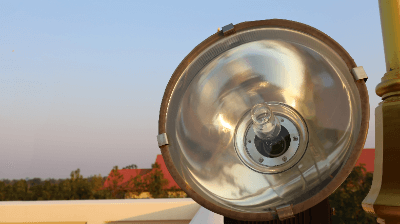What Is an HID Floodlight?

An HID floodlight is a generic term for floodlights with a high intensity discharge, and is distinguished from LED-based lighting.
HID stands for high-intensity discharge. Floodlights, on the other hand, are lighting fixtures that emit a specialized, intense light in a certain direction by using a reflector or lens.
Since different light sources have different characteristics, such as life span and power consumption, it is important to select the appropriate one for the uses of the light source.
Uses of HID Floodlights
Floodlights are characterized by high luminance due to their powerful luminescence. Since the direction of the light can be freely determined, they are used in places where the irradiation position needs to be adjusted arbitrarily rather than in places where the irradiation position is fixed, such as streetlights.
However, HID floodlights need to be installed in consideration of the spread of light because the light leaking outside of the irradiation target is large depending on the uses of the HID floodlight. Outdoors, HID floodlights are used as nighttime lighting for signboards, warehouses, and sports grounds, and indoors, they are used for lighting in heavy machinery factories with high ceilings.
In particular, when used for nighttime lighting on sports grounds, metal halide light sources are selected for nighttime lighting in consideration of visibility by players and spectators, as well as color rendering for broadcasting purposes.
For factory lighting, metal halide is often used because of its visibility and workability, as well as because of the Sustainable Development Goals (SDGs) and proactive efforts to conserve energy.
In recent years, ceramic metal halide light sources with high efficiency and high color rendering have become popular along with longer lamp life and improved luminous flux maintenance rate.
Principle of HID Floodlights
HID floodlights illuminate the surroundings by projecting the light produced by the discharge of an HID lamp in a specific direction through a reflector or lens. The mechanism of light emission by this discharge is generally the same for fluorescent lamps. However, incandescent and halogen lamps have a different principle of emitting light from an internal filament.
For example, in a metal halide lamp, a metal halide substance such as sodium is sealed inside the light-emitting tube, and when voltage is applied to the electrodes, thermal electrons are emitted from them. Visible light is the light produced when these emitted heat electrons collide with metal atoms. In addition to sodium, a wide variety of metal halide materials are used for encapsulation inside the light-emitting tube, including mercury and iridium.
Since the luminous characteristics of lamps vary depending on the type and amount of the metal substance sealed inside, it is possible to obtain the optimum light intensity by selecting HID lamps according to the desired light characteristics.
Types of HID Floodlights
HID Floodlights have the following types of light sources, each with different characteristics.
1. Mercury Lamp
Mercury lamps use the light emitted when mercury vapor is discharged. The light is emitted by heating mercury and argon enclosed in a light-emitting tube to increase the vapor pressure of the mercury.
This light source requires a ballast to prevent the voltage inside the light-emitting tube from dropping and breaking down. It is widely used because it is inexpensive and versatile, but it takes time for the light to turn on. Also, it cannot be used until the temperature drops after the light is turned off.
2. Metal Halide Lamp
Metal halide lamps use the principle of emitting light when a mixture of mercury and metal halide vapor enclosed in a light-emitting tube is discharged. Therefore, like mercury lamps, they require a ballast.
The lamp’s light tint can be changed by adjusting the amount of iodide used. They consume less power and have a longer life than mercury lamps, but the lamps themselves are expensive.
3. Halogen Lamp
Halogen lamps emit light when an incandescent lamp is filled with halogen gas and the filament is energized to incandescence. Halogen atoms in the lamp combine with tungsten atoms when the lamp is energized to form halogen, preventing damage to the filament and extending its service life.
Also, because they are extremely bright and efficient, they feature high performance even in small bulbs. However, they are also characterized by extremely high temperatures.
Structure of HID Floodlights
HID Floodlights generally consist of a light source tube, reflector, full face, support, arm, pedestal, and handle.
1. Light Source Tube
The light source tube is the light emitting part and is mainly made of steel plate; some lamps used in HID floodlights emit light at high temperatures, so a more suitable material may be selected.
2. Reflector
Reflectors are mirrors used to collect the light from HID lamps and project it in a specific direction. There are various types of reflectors, such as flat, spherical, and parabolic mirrors, with built-in reflectors suitable for the installation environment. Aluminum is mainly used as the material, and products coated with silica glass or other materials are also available to further improve reflection efficiency.
3. All Surfaces
The full face section is a cover for efficient illumination of the light. The full face also serves to protect the inside of the floodlight from water droplets and dust. Transparent tempered glass is mainly used as the material.
4. Support, Arm, Pedestal, Handle
The support is a reinforcing member to support the light source tube. The arm is an adjusting part to fix the projection direction adjusted by the handle. The pedestal is a mounting base for fixing the HID floodlight. The handle is the moving part for adjusting the light direction from the light source tube. These components may not be included in some portable HID floodlights.
Portable HID floodlights suitable for disaster situations are also available. By attaching a special lens cover, the direction of light emission can be widened or focused on a specific area.